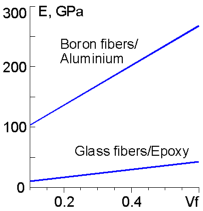 The modulus of an unidirectional composite along the fiber direction can be calculated by the rule of mixtures:
The modulus of an unidirectional composite along the fiber direction can be calculated by the rule of mixtures:
Ec = EfVf + EmVm,
where Ef - the modulus of the fiber; Em - is the modulus of the matrix; Vf, Vm - the volume fraction occupied by the fibers and the matrix respectively.
 A cross-ply composite laminate [0o/90o], shown at the right, will warp under uniaxial tensile stress due to the difference in stiffness along and perpendicular to the fiber axis. The stiffness along the fiber axis is greater and therefore the ply with fibers parallel to the applied stress will be stretched less than the ply loaded across the fibers.
A cross-ply composite laminate [0o/90o], shown at the right, will warp under uniaxial tensile stress due to the difference in stiffness along and perpendicular to the fiber axis. The stiffness along the fiber axis is greater and therefore the ply with fibers parallel to the applied stress will be stretched less than the ply loaded across the fibers.
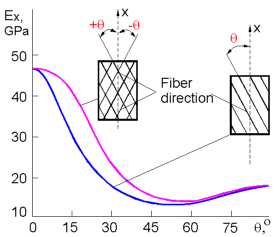 The elastic modulus of continuous fiber composites strongly depends on the angle between the fiber direction and the applied load. The maximum stiffness of the composite is achieved when the applied load is parallel to the fiber direction. The stiffness of cross-ply composites [+q/-q] is greater than that of the unidirectional composite due to additional restraint to shear deformation.
The elastic modulus of continuous fiber composites strongly depends on the angle between the fiber direction and the applied load. The maximum stiffness of the composite is achieved when the applied load is parallel to the fiber direction. The stiffness of cross-ply composites [+q/-q] is greater than that of the unidirectional composite due to additional restraint to shear deformation.
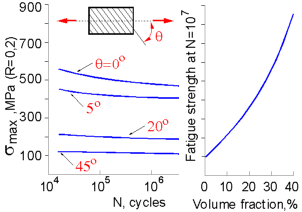 The greater the volume fraction Vf of fibrous unidirectional composites the higher their capability to sustain cyclic loading. The resistance to fatigue of composites strongly depends on the angle q between the direction of applied loading and the fiber axis. The fatigue strength decreases when the angle increases.
The greater the volume fraction Vf of fibrous unidirectional composites the higher their capability to sustain cyclic loading. The resistance to fatigue of composites strongly depends on the angle q between the direction of applied loading and the fiber axis. The fatigue strength decreases when the angle increases.
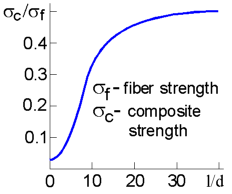 Composites with short fibers display a greater strength with an increase in the ratio of fiber length to diameter l/d. As the number of defects decreases along with the fiber diameter the strength increases. Additionally, for the same volume fraction the longer fibers can support a greater portion of the load transferred from the matrix.
Composites with short fibers display a greater strength with an increase in the ratio of fiber length to diameter l/d. As the number of defects decreases along with the fiber diameter the strength increases. Additionally, for the same volume fraction the longer fibers can support a greater portion of the load transferred from the matrix.
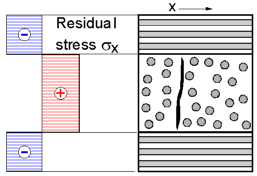 Residual stresses are developed during the cooling of cross ply composite laminates due to anisotropy of thermal contraction parallel and perpendicular to the fiber direction. In glass fibers/epoxy composites the thermal expansion coefficient along the fiber direction is greater than that perpendicular to the fibers. Following the cooling the plies of 90o are in tension and the plies of 0o are in compression. Generally, cracks are formed perpendicularly to the tensile stress.
Residual stresses are developed during the cooling of cross ply composite laminates due to anisotropy of thermal contraction parallel and perpendicular to the fiber direction. In glass fibers/epoxy composites the thermal expansion coefficient along the fiber direction is greater than that perpendicular to the fibers. Following the cooling the plies of 90o are in tension and the plies of 0o are in compression. Generally, cracks are formed perpendicularly to the tensile stress.
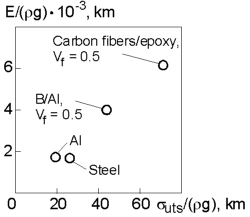 Composites are known to have a large specific strength, which is defined as the ratio of the ultimate tensile strength suts to the weight rg.
Composites are known to have a large specific strength, which is defined as the ratio of the ultimate tensile strength suts to the weight rg.
Specific strength of continuous fibers composites is much greater than that of such conventional materials as aluminium or steel.
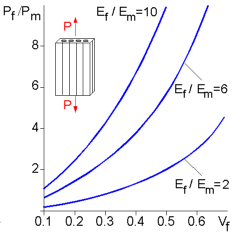 The load applied to a fiber composite is supported by both the fibers and matrix. The relationship between the load carried by fibers Pf and matrix Pm depends on the ratio EfVf to EmVm:
The load applied to a fiber composite is supported by both the fibers and matrix. The relationship between the load carried by fibers Pf and matrix Pm depends on the ratio EfVf to EmVm:
Pf / Pm = EfVf / EmVm,
where Ef, Em, Vf and Vm represent the elastic modulus and the volume fraction of the composite components. The higher the elastic modulus and the volume fraction, the greater portion of the applied load is carried by the fibers.
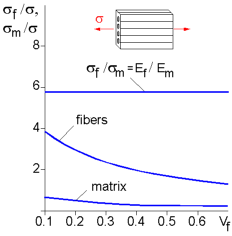 Assuming no slip between the fibers and matrix the stress acting on the composite is determined by the following:
Assuming no slip between the fibers and matrix the stress acting on the composite is determined by the following:
s = sfVf + smVm
where Vf and Vf - the volume fraction of the fibers and matrix respectively.
The stress in the matrix
sm = sf x Em/Ef.
The stress in the fibers:
sf = s / [Vf + (1-Vf) x Em/Ef].
Assuming a constant applied stress, the greater the volume fraction of the fibers the less they are stressed.
 2015-08-13
2015-08-13 414
414








